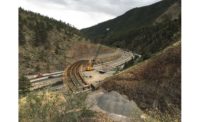ENR Mountain States 2023 Best Projects
Best Project Highway/Bridge: Colorado Department of Transportation Central 70

Photo courtesy Kiewit
Colorado Dept. of Transportation Central 70
Denver
Best Project
Submitted by: Atkins
Owner: Colorado Dept. of Transportation
Lead Design Firm: WSP USA Inc.
General Contractor: Kiewit Infrastructure
Owner’s Representative: Atkins North America
Construction Manager: RS&H
At $1.3 billion, Central 70 is Colorado’s largest highway infrastructure project in state history. Made possible through a public-private partnership, the project rebuilt 10 miles of Interstate 70, added an express lane in each direction, removed a 50-year-old viaduct and lowered the interstate below grade between Brighton and Colorado boulevards.
I-70, the major east-west artery for the Denver area, connects downtown and the airport and sees 200,000 vehicles per day. The project crossed several environmental justice communities and two Superfund sites, along with mixed industrial and residential areas north of downtown Denver.
Completed within budget and on schedule in February 2023, the project’s scope included numerous mitigations, from remodeling of a neighborhood school to a $2-million contribution to an affordable housing fund and construction of a four-acre park over a portion of the lowered section of I-70. The effort also required a complex phasing approach to limit impacts to the traveling public and the surrounding neighborhood and businesses.

Photo courtesy Atkins
One of the most difficult parts of the project involved lowering the interstate approximately 60 ft immediately adjacent to the existing I-70 viaduct—which had one of the lowest bridge ratings in the state—while also maintaining local connectivity between the residential neighborhoods on either side. The team built new bridges at grade under the existing viaduct, utilizing low overhead clearance equipment while avoiding the viaduct’s existing foundations. Once the new bridges were in place, excavation began on I-70’s future westbound lanes. When finished, the westbound lanes took over all traffic from the viaduct—using a temporary head-to-head configuration on the new pavement—and demolition proceeded on the viaduct. Then, excavation and construction began on the new eastbound lanes where the viaduct once stood.
Crews also had to maintain operations for three different railroads, including a bridge immediately adjacent to the busiest railroad yard in the Denver metro area. This work required complex construction and phasing to complete the new structures while accommodating up to 25 train crossings per day.



